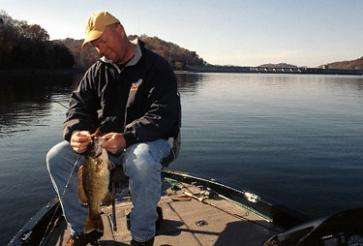
Last week we talked about falling water and how it sends bass to the bluffs. This week I want to talk about the best lures and presentations for falling water smallmouths.
If I was restricted to three baits under these conditions, they would be (1) a 3/16-ounce Punisher jig in camo craw or black and blue craw, (2) a 5-inch Berkley Hollow Belly swimbait in gizzard shad, and (3) a 2 1/2-inch Lunker City Fin-S Fish in ice shad fished on a 1/16-ounce jighead.
The beauty of these baits is that by using different line sizes I can not only fish them at almost any depth, but I can control their rate of fall and thereby match the mood of the bass that are typically suspended when the water level is falling.
With the Punisher hair jig, I typically use 10- to 12-pound fluorocarbon line on a baitcaster. Even in clear water I like the heavier line because it will slow the fall of the lure, and I think the fluorocarbon is a lot less visible than monofilament. It might seem like awfully heavy line in some circumstances, but I like the slow fall when targeting suspended bass near bluffs and steep drops.
I’ll use the same line for the Berkley Hollow Belly. A lot of folks might think a 5-inch swimbait is too much lure for smallmouths, but I like it. It’s big, but it’s a good-sized meal for the lunkers I want to catch.
I don’t know about you, but I’d rather catch one bass over 5 pounds than 10 that weigh 2 pounds apiece. Besides, the jig and Fin-S Fish will catch plenty of numbers for you. You need to have another bait in your mix that will help you target bigger fish.
Speaking of the Fin-S Fish, I like to fish it on fluorocarbon line, too, but with it I use 6- to 8-pound line on a spinning outfit.
As we noted last week, falling water means it’s time to head for bluffs and steep drops. It also means that a lot of the smallies will suspend. With those three baits, you’ll be ready for them and able to present a lure to them at whatever depth they might be holding.
When I’m working a rocky bluff, I like to use the Punisher jig by making perpendicular or 45-degree casts in toward the bluff. I want my jig to land as close to the bluff as I can get it, and then I want it to fall vertically to the bottom.
Once it hits bottom, I lift it very slightly and tight-line it down to the next little ledge. That usually means you only have to move it an inch or two. Sometimes, if the face of the bluff wall is really sheer, the jig may just free fall with nothing to stop it. That’s OK. Smallmouth will still use that bluff. To fish these banks, just let your bait fall down to the level where you’ve seen bass or bait on your electronics and engage your reel. By doing this, you’ll put tension on the line and cause the bait to swing away from the bluff … right into where the bass are holding.
Count your jig down. Give it 10 seconds a few times and then 15 or 20. The longer you count before engaging the reel, the deeper it goes. Experiment with this until you zero-in on the right level, then repeat that magic number and catch a bunch of fish.
I do the same thing with the Fin-S Fish, except that I swim it a little more. It’s a great little baitfish imitation.
With the swimbait, I like to parallel the bluffs and make long casts. Then I count the bait down and slowly crank it back. With a little practice you can find the right retrieve speed to make the tail kick just right. Then it’s a matter of finding the right depth and keeping it there.
Don’t let falling water levels get you down. Find a bluff and work it for some of the most predictable and reliable smallmouth of the year.
Until next time, if you have any questions or comments, I’d love to hear from you. Please e-mail me atStephen@thesmallmouthguru.com.





